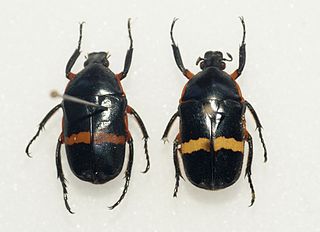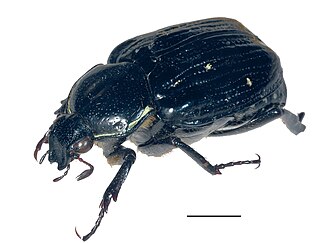
Aphodiinae is a subfamily of the scarab beetle family, Scarabaeidae. Members of this subfamily are known commonly as the small dung beetles and many, but not all, are dung beetles. These beetles are found worldwide.

Flower chafers are a group of scarab beetles comprising the subfamily Cetoniinae. Many species are diurnal and visit flowers for pollen and nectar, or to browse on the petals. Some species also feed on fruit. The group is also called fruit and flower chafers, flower beetles and flower scarabs. There are around 4,000 species, many of them still undescribed.
Ochicanthon is a genus of Scarabaeidae or scarab beetles in the superfamily Scarabaeoidea.

Termitotrox cupido is a species of scarab beetle in the subfamily Termitotroginae. It was first described by Munetoshi Maruyama in 2012, having been discovered living inside a nest of the termite Hypotermes makhamensis in Cambodia. It is a tiny, blind and flightless insect.
Hypotermes makhamensis is a species of termite in the subfamily Macrotermitinae of the family Termitidae. It lives in dry evergreen forests in tropical south-eastern Asia and builds termite mounds in which it cultivates fungus for use as food.

Chondrorrhina is a genus of fruit and flower chafers belonging to the family Scarabaeidae, subfamily Cetoniinae, found in Africa.

Coprini is a tribe of scarab beetles, in the dung beetle subfamily (Scarabaeinae). Scholtz et al. describe them as tunnellers that are shiny black, of moderate to large size and with a strongly convex shape. They also, however state that the grouping based on these characteristics has little phylogenetic validity, and the placement of several genera in this and related tribes is likely to change.

Platytomus is a genus of aphodiine dung beetles in the family Scarabaeidae. There are more than 20 described species in Platytomus.
Oxygrylius is a genus of rhinoceros beetles in the family Scarabaeidae. There are at least two described species in Oxygrylius.
Euparia is a genus of aphodiine dung beetles in the family Scarabaeidae. There are about six described species in Euparia.
Euetheola is a genus of rhinoceros beetles in the family Scarabaeidae. There are about seven described species in Euetheola.
Anoplognatho is a genus of rhinoceros beetles in the family Scarabaeidae. There is one described species in Anoplognatho, A. dunnianus.

Ancognatha is a genus of rhinoceros beetles in the family Scarabaeidae. There are more than 20 described species in Ancognatha.

Dyscinetus is a genus of rice beetles in the family Scarabaeidae. There are more than 20 described species in Dyscinetus.
Genuchinus is a genus of myermecophilic beetles in the family Scarabaeidae. There are about 10 described species in Genuchinus.
Coscinocephalus is a genus of rhinoceros beetles in the family Scarabaeidae. There are at least two described species in Coscinocephalus.

Callistethus is a genus of shining leaf chafers in the beetle family Scarabaeidae. There are at least 130 described species in Callistethus.

Giesbertiolus is a genus of scarab beetle belonging to the subfamily Cetoniinae. It contains four species, although the placement of G. linnaei is regarded as tentative.
Haroldius is a genus of scarab beetles in the family Scarabaeidae. There are more than 30 described species in Haroldius. They are found in Asia, Africa, and Oceania.

Termitophiles are macro-organisms adapted to live in association with termites or their nests. They include vertebrates, invertebrates and fungi and can either be obligate termitophiles or non-obligate termitophiles. Termitophiles may spend a just a part or the whole of their lifecycle inside a termite nest. The term termitariophily has been suggested as a term to describe the situation where a foreign organism merely uses the termite nest.










